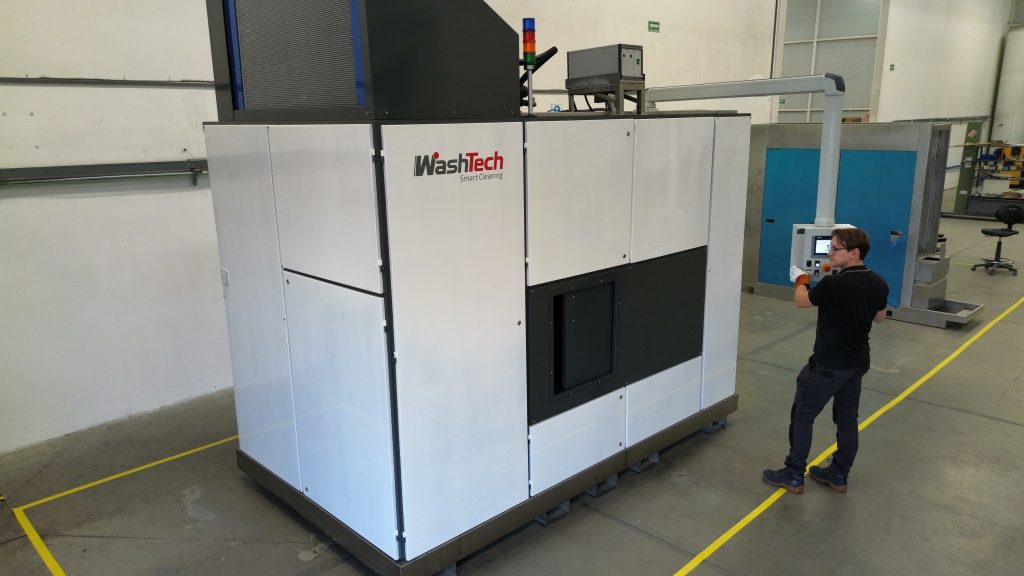Industrial degreasing is a key stage in automotive production, as it ensures the cleanliness of parts and components before assembly, coating, or heat treatment. The automotive industry, known for its high quality standards, requires advanced cleaning solutions that optimize time, reduce resource consumption, and comply with increasingly strict environmental regulations.
In this article, we explore the latest trends in industrial degreasing applied to the automotive sector, the most innovative technologies, the impact of sustainability on these processes, and the specialized equipment that maximizes efficiency without compromising quality.
Industrial Degreasing in the Automotive Production Chain
Critical Components Requiring Deep Cleaning
In the automotive industry, many components require a meticulous degreasing process before assembly or finishing. Parts such as engine blocks, gears, pistons, brake systems, and transmissions accumulate residues of oils, greases, and metal particles that must be removed to ensure proper operation and durability.
Degreasing is essential not only to improve the performance of these components but also to prevent defects in subsequent processes such as painting, coating, or heat treatment.
Quality Standards Required by the Automotive Industry
The automotive sector operates under strict quality standards such as ISO 16232 (cleanliness of automotive components) and IATF 16949 (quality management in the automotive industry). These standards define specific parameters regarding part cleanliness, determining the maximum permissible level of contaminants for each component.
Complying with these standards is fundamental to ensuring the safety, efficiency, and longevity of vehicles, compelling companies to implement high-precision degreasing solutions.
Impact of Degreasing on Vehicle Durability and Safety
Poor cleaning of automotive components can lead to premature failures, accelerated wear, or even critical safety issues. The presence of residues in brake systems, for instance, can affect braking capacity, while contaminants in engines can reduce efficiency and cause costly breakdowns.
Adopting innovative degreasing technologies not only improves vehicle quality but also contributes to driver safety and strengthens the reputation of automotive brands.

Most Common Industrial Degreasing Methods in the Automotive Industry
There are multiple cleaning methods for automotive parts, but the most commonly used are immersion degreasing and spray cleaning.
Both methods can be enhanced with advanced technologies such as ultrasonic cleaning or filtration systems to improve process efficiency.
Ultrasonic cleaning has revolutionized industrial degreasing, especially in the automotive industry. This method uses high-frequency sound waves to create microscopic bubbles in a cleaning liquid, eliminating dirt, grease, and particles without mechanical friction.
Advantages include:
This technique is ideal for precision parts and electronic components in modern vehicles.
The use of superheated steam and high-pressure systems has become an eco-friendly alternative for automotive degreasing. These methods use temperature and pressure to dissolve oils and greases without aggressive chemical solvents.
Main advantages:
This type of cleaning is particularly useful for engines, transmissions, and exhaust systems, where residue buildup can affect vehicle performance and efficiency.
Innovations in Automotive Degreasing: Greater Efficiency and Sustainability
The environmental impact of industrial degreasing has driven the development of eco-friendly solvents that replace traditional chemical compounds without compromising process effectiveness.
These include:
These innovations allow companies to comply with strict environmental regulations while maintaining cleaning efficiency.
Modern degreasing systems incorporate automation that monitors and adjusts variables such as temperature, pressure, and chemical concentration in real time.
Benefits of automation:
This trend is driving the adoption of intelligent cleaning lines integrated into automotive production chains.
Sustainability in the automotive industry has led to the development of degreasing equipment with closed-loop recirculation systems that optimize water use and minimize waste generation.
Key features:
Trends in automotive industrial degreasing are revolutionizing component cleaning through more efficient, sustainable, and automated technologies. Methods such as ultrasonic cleaning, steam degreasing, and eco-friendly solvents not only optimize processes but also ensure compliance with increasingly stringent environmental standards.
The automotive industry demands advanced solutions to guarantee the quality and durability of its components, preventing failures that could compromise vehicle safety. Investing in next-generation degreasing equipment reduces operational costs, improves production efficiency, and minimizes environmental impact.
At WashTech, we provide innovative technology to optimize degreasing in the automotive industry. Contact us and discover how our solutions can enhance your industrial cleaning processes.